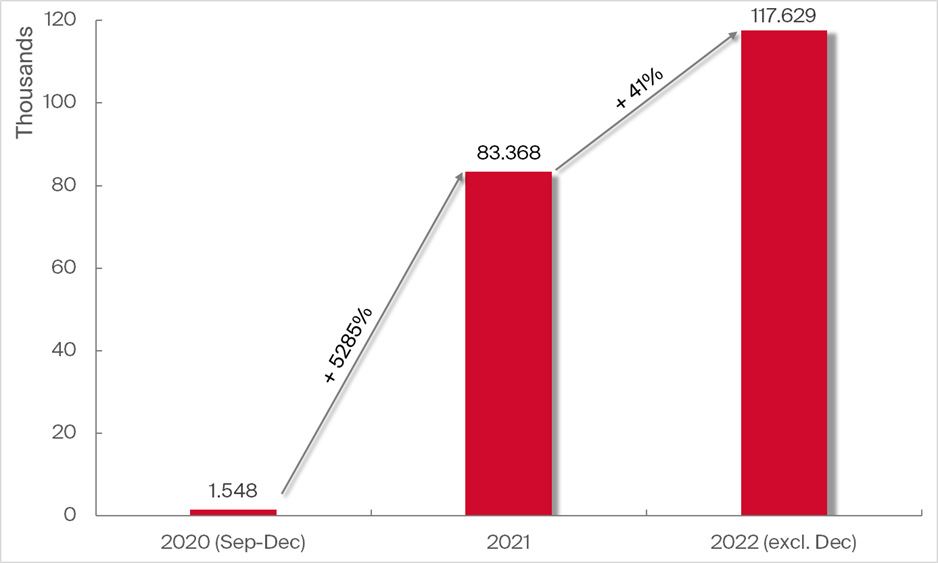
All-time-high rug pulls in 2022, crypto penetrates Latin America, auditors turn back on crypto industry

Merry Disclaimer: As the holiday season nears, we at Bitcoin Suisse wish you a Happy Holiday and are looking forward to welcoming you back for a more promising ´23. For now, we will leave you with this year´s last edition and a crypto inspired poem:
Roses are red, violets are blue
Crypto winters are long and cold
But HODLERS shall make it through
No worries, Bitcoin’s promises are bold
So let´s work hard and make it more than a notion
But now it´s time to show your loved ones some devotion
1. Unscrupulous: most crypto rug pulls ever since
The Facts:
- The number of fraudulent tokens created reached an all-time-high this year, as Solidus Lab´s research report shows, affecting more users than the biggest crypto bankruptcies to date.
- Over the past two years, 1.93 million users lost money due to rug pulls, compared to an aggregated 2.3 million users affected across six bankruptcies (Mt. Gox and LUNA collapse as well as Celsius´, Voyager´s, FTX´s and BlockFi´s bankruptcies.
- Rug pulls are defined as events where investors lose money due to the token creators abandoning the project, dumping (selling their holdings) on investors, pumping (manipulating the price upwards) their tokens, or creating malevolent smart contracts that exploit users' funds.
- The report finds that 12% out of all BEP-20 tokens on the Binance Smart Chain (BSC) are fraudulent, on the Ethereum network 8% out of all ERC-20 tokens are fraudulent.
Why it’s important:
- As of December 2022, there are more than 22,000 crypto assets in existence according to Coinmarketcap, and it gives rise to the question how many of them were set up with legitimate intentions.
- The report is an important contribution to shed on the unnoticed part of scams within the crypto industry, as the majority remains undiscovered, and does not receive large media outcries such as the Squid Game token fraud.
- As 99% of fraudulent funds embezzled in scams remain undetected there is a lot of potential for improvement on due diligence, not from a KYC perspective, but rather a “funds origination” history for CeFi and DeFi actors.
- As the recent report uncovered, a large portion of crypto tokens are created with direct malicious intention in order to abstract funds from unexpecting investors.
- An intention to provide added value for users is therefore absent and the entire tokenomics (token supply structure) is set up to favor its founders, and the team behind the project.
- The finding of the study aligns with DOGE founder Billy Marcus recently stating that 95% of crypto tokens are scams.
- The repercussions of the fraudulent tokens being deployed will not only shed a bad light on the industry as a whole but could draw negative attention from regulators and governments.
- Also, honest players and projects with good intentions, actual use cases with real adoption might be discredited and negatively affected by the bad players.
- Another troublesome fact is that more than 11 billion U.S. Dollars’ worth of scammed ETH have been transferred through CeFi (centralized finance) exchanges.
- Nevertheless, the total volume of fraudulent funds is still relatively small and crypto as an asset class is quite “free” from malicious activity, with 0.34% out of all crypto transactions, compared to 2-5% of global GDP stemming from illicit activity
2. Dissemination: crypto spreads throughout Latin America
The Facts:
- Institutional clients from Latin America (LatAm) seek exposure to U.S. Dollars in the form of stablecoins, as inflation and economic hardship are on the rise.
- Total Value Settled via stablecoins reached a stunning 7 trillion U.S. Dollars this year, exceeding the likes of Mastercard (2.2 trillion U.S. Dollar) or Amex (1 trillion U.S. Dollar).
- Institutions and people see improved liquidity in crypto markets and experience easier access to financial markets.
- The trend is backed by Brazil passing the recently mentioned crypto bill (Weekly Wrap December 2nd) into law this week.
Why it’s important:
- LatAM faces times of severe inflation and civil unrest, with Argentina seeing annual inflation beyond 90%.
- Not many citizens nor businesses have proper access to foreign exchange (FX) to enable inflation hedges such as holding U.S. Dollars rather than their local currency.
- Despite tough times people and businesses found a way to adapt and persist, finding their safe haven in the crypto markets, enabling them to escape their inflating fiat currencies.
- Institutions and people turning to crypto as a permissionless decentralized alternative to centralized governments and government-controlled fiat currency is a strong endorsement for the crypto industry, despite the continuing crypto winter.
- Especially ease of access and non-discriminatory treatment in global financial markets should boost future adoption of crypto in Latin America and developing countries even further.
3. Unexamined: crypto industry loses auditors Mazars and Armanino
The Facts:
- Crypto auditors Mazars and Armanino cut their ties with the crypto industry and seize to issue audits after years of collaboration.
- Amongst Mazars Group`s clients are the exchanges Binance, KuCoin and Crypto.com
- Kraken, Gate.io, Ledn, Nexo and FTX US rank among Armanino´s regular customers.
- This week Mazars also withdrew Binance´s recently published proof-of-reserves report, by deleting the resources off its website.
- Mazars justified its decision as there are “concerns” over its public image and its auditing clients outside of crypto, due to the recent events in the crypto industry.
- Although they are crypto “auditing” firms, they do not issue audits in the traditional finance sense for registered public companies, but rather a selective accreditation of asset holdings / Assets under Custody (AuC) for certain exchanges for example.
- Accounting firms are deterred to work with crypto exchanges, while crypto insiders consider auditors such as the Big Four to “not know how to audit crypto exchanges”.
Why it’s important:
- Overall, there are various issues with regards to reporting and auditing crypto companies, as they seem mostly untransparent due to the opaque structures and layers of crypto as an asset class, making proper audit tedious and unfeasible.
- Especially the recent CeFi bankruptcies within the crypto industry leave investors and stakeholders with unanswered questions and concerns about the solvency and holdings of crypto exchanges and businesses.
- In the interim, the crypto industry might be exposed to less transparency, as less auditing firms remain, amplifying future issues, as it becomes harder to monitor liquidity and financial risk of CeFi platforms.
- The combination of no auditors, no clear regulation, bear market and general scrutiny from officials and governments in the aftermath of bankruptcies, scandals of fraud and embezzlement of funds, misappropriation of funds and corporate excesses can be considered a strong indicator of tough times ahead.
- Most crypto companies are privately held, in contrast to Coinbase (COIN) being listed on a public stock exchange for example, implying they do not publish any financial data or financial reports.
- There is a need for proper audit and actual proof-of-reserves, as despite factual reserves, liabilities and creditworthiness are excluded from current evaluations and auditing reports.
- The quality of past reports is questionable, as Armanino produced a clean audit for FTX US’ for 2021, failing to recognize the flaws of internal financial and corporate controls.
- Nevertheless, recent moves in the right direction such as (partially) accredited proof-of-reserves will be discontinued for now, hurting industry participants and investors the most.
- The lack of auditors might be devastating in the current crypto and macro environment, as it spreads and exacerbates Fear Uncertainty and Doubt (FUD) in the markets amidst the most recent events and fallouts.
- Lastly, a reemergence and rise of “not your keys not your coins” (i.e., self-custody) can be observed as withdrawals from exchanges to private wallets are increasing.
In other news
- Bitcoin Suisse Liechtenstein CEO interview (via Cointelegraph)
- Grayscale may consider buyback of GBTC (via Cryptoslate)
- Two of Sam Bankman-Fried´s aides plead guilty (via Coinmarketcap)
- Crypto miner Core Scientific filing for bankruptcy (via Reuters)
- Binance acquires bankrupt Voyager for $1.02 billion (via Binance)
- Nigerian bill recognizes crypto as investment capital (via Coindesk)
- BlockFi wallet account owners may soon withdraw funds (via BlockFi)
- Crypto is a proven use case for developing economies (via Kaiko)
- OKX Exchange withdrawals halted due to cloud issues (via TheBlock)
The global monetary system is therefore ironically a big barter system. Rather than having one or two forms of money that we all use, there are 180 different monies, each with their local monopolies. Only a handful of them such as dollars and euros (and gold, more slowly) are globally salable to a decent degree.
Lyn Alden on the World´s Payment Problems – via December 2022 Newsletter
350
- The amount of fraudulent “scam tokens” created every single day in 2022
Plotting the number of fraudulent tokens deployed per year

Missing the fundamentals? Read our introduction to “What are Staking Rewards”
The latest episode of Decrypt titled “Status quo of NFTs – Part II” highlights the breakthrough of NFT markets after the 2021 wave and looks at adoption trends beyond art and collectibles.